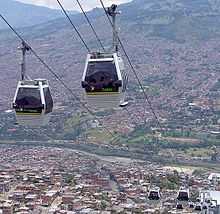Metrocable (Medellín)
| Metrocable (Medellín) | |
|---|---|
 | |
| Overview | |
| Status | Operational |
| Character | Gondola lift |
| Location | Medellín, Colombia |
| Open | 2004 |
| Operation | |
| Operator | Metro de Medellín |
| Technical features | |
| Line length | 2,072 m (6,798 ft) |
| Operating speed | 10 miles per hour (16 km/h) |
| Notes |
elevation: 399 m (1,309 ft) Electric motor powering cable bullwheel |
Metrocable is a gondola lift system implemented by the City Council of Medellín, Colombia, with the purpose of providing a complementary transportation service to that of Medellín's Metro. It was designed to reach some of the least developed suburban areas of Medellín. and is largely considered to be the first Cable Propelled Transit system in South America.[1] The initial conception of this system was indirectly inspired by the Caracas Aerial Tramway (also known as the Mount Avila Gondola) which was designed primarily to carry passengers to a luxury hotel.
Metrocable is the first system in the world dedicated to public transport, with identical service times. Since starting operations in 2004, carries 30,000 people daily and operationally integrated mass transit system such as the Metro.
As of 2010, the Medellin Metrocable system contained three lines, namely Line K, Line J and Line L (Cable Arvi). Overall, the system has been received with enthusiasm by the locals.
Description
Medellín is a city located in the Aburra Valley and it is therefore surrounded by hills. Many of those hills are home to underdeveloped barrios (comunas), which due to their location cannot be reached by Medellín's biggest mass transportation system Metro. Many of these barrios are in fact located in very steep grounds to the extent that not even a regular bus system could be either useful or commercially profitable. Before the implementation of the Metrocable Line K, residents of the Santo Domingo barrio, spent upwards of 21⁄2 hours commuting to work each way.
The Metrocable system is a branch of Medellín's metro and it is managed by the corporation Metro of Medellín. The system uses Monocable Detachable Gondola technology which consists of cable cars connected to a fixed cable through means of a detachable grip. The haulage cable is pulled by large wheels allowing the cabins to move at an average speed of 10 miles per hour (16 km/h).
Routes
At the present time three Metrocable lines have been built - Line J, Line K and Line L.
Line K
Line K was the initial line that was built and was first opened in 2004. It is 1.8 km and contains the following four stations: Acevedo, Andalucia, Popular, and Santo Domingo.
Construction costs are estimated at $26 million USD.[2]
Line J
Soon after officials saw the enormous success of Line K, plans to proceed with another line - Line J - was immediately on the table. It officially opened in 2008.[3] Similar to Line K, it also has four stations: San Javier, Juan XXIII, Vallejuelos and La Aurora. The entire length of Line J runs along 2.7 km of cable.
Line L
Line L does not serve communal areas, rather, it is a tourist-oriented line which is connected to Arví Park and is part of a social project to bring retreats and nature to the masses.[4] Passengers must pay an extra fare - 4,000 Colombian Pesos ($2 USD approx.) to ride this line.
It is connected to Line K's terminus station - Santo Domingo. It is also expected that this new line will help promote and develop tourism in the rural areas around Lake Guarne. It will take 14 minutes to ascend to El Tambo and there will be no intermediate stations.
Public Transit
Aerial lifts are not often used as a mass transportation system, although they can be used as such. In reality, they are becoming more popular with examples which include the Metrocable system in Caracas, Venezuela, the Mi Teleférico system in La Paz, Bolivia, and, in the United States, the Roosevelt Island Tramway in New York City and the Portland Aerial Tram in Portland, Oregon.
Inspired by Medellín's Metrocable, Rio de Janeiro, Brazil, has also opened up a gondola lift and became the third South American city to implement a gondola system for urban transit usage.[5] It is serving the communities of Complexo do Alemão in the North Zone of the city[6] and became operational in summer 2011.
While gondolas used as transit offer many advantages such as cost-effectiveness, low emissions and energy efficiency, one of the disadvantages of gondolas is the risk of power outages. In case of a hazard or an emergency it is not possible to exit the cabins. However, Medellín Metro is ameliorating this problem by providing a communication system in every vehicle should an emergency occur.
References
- ↑ The Gondola Project Medellin/Caracas, Part 1 - Retrieved on 2010-03-14
- ↑ The Gondola Project Medellin/Caracas, Part 2 - Retrieved on 2010-03-12
- ↑ The Gondola Project Medellin/Caracas, Part 3 - Retrieved on 2010-03-14
- ↑ The Gondola Project Medellin/Caracas, Part 4 - Retrieved on 2010-03-15
- ↑ Sports Features President of Rio 2016 visits Complexo do Alemao cable car system - Retrieved on 2010-12-24
- ↑ "Rio to Open Urban Gondola System This Year". The Gondola Project. Retrieved March 9, 2011. Includes route overview.
See also
![]() Media related to Metrocable at Wikimedia Commons
Media related to Metrocable at Wikimedia Commons
- Metro de Medellín
- Metrocable (Caracas)
| ||||||||||||||||||||
| ||||||||||||||||||||||||||||||